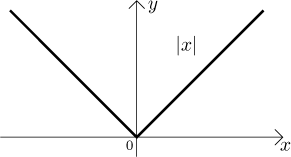Definition.
The absolute value of a real number x,
denoted
![]()
Definition.
The absolute value of a real number x, denoted|x|, is defined by
Example:
Note: Normally, when defining a function by cases, the domains of
individual cases must be disjoint. Here we put equality with both variants,
since when
The graph:

Properties are clear from the picture, the function is continuous, even,
decreasing on
![]()
There is no derivative at 0, but we have one-sided derivatives there,
The absolute value is a very popular source of trouble for students, very often they try to take a derivative somehow, arriving at most amazing conclusions. Unfortunately, very little can be done (computationally) with absolute value directly. For most purposes we have to get rid of it by splitting the situation into cases depending on the sign of the expression inside the absolute value (according to the definition) and then work on. If you remember this, you should not run in trouble. For details and examples, see for instance the section on working with split functions in Derivatives - Methods Survey - Graphing functions, and Graphing functions in Derivative - Solved Problems.
Note: There is an alternative way to write the absolute value: